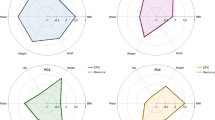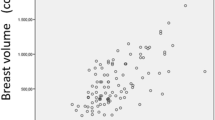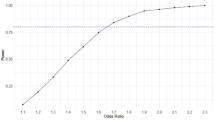Summary
Mammographic parenchymal patterns are related to breast cancer risk and are also affected by anthropometric measure. We carried out a case–control study comprising 200 cases with high-risk (P2 and DY) mammographic parenchymal pattern and 200 controls with low-risk (N1 and P1) patterns in order to investigate the effect of body size and shape and breast size on mammographic patterns. Women in the highest quartile of body mass index (BMI) distribution were significantly less likely to have a high-risk pattern (odds ratio (OR) = 0.21, 95% confidence interval (CI) 0.08–0.52, P-value for trend = 0.001) compared to those in the lowest quartile. Relative to women with a waist to hip ratio (WHR) of less than 0.75, the OR of having a high-risk pattern in women with a WHR greater than 0.80 was 0.30 (95% CI 0.14–0.63). Breast size as measured by cup size was significantly and negatively related to high-risk pattern. Our study indicates that both BMI and WHR are negatively associated with high-risk patterns. However, both phenomena are associated with increased risk of breast cancer in post-menopausal women. This negative confounding of two positive risk factors means that the effect of parenchymal patterns on risk will tend to be underestimated when not adjusted for BMI and WHR and vice versa. Thus we may have underestimated the importance of BMI and mammographic parenchymal patterns in the past. Further studies are needed to determine a measure of parenchymal density that is independent of anthropometric measures and breast size.
Similar content being viewed by others
Article PDF
Change history
16 November 2011
This paper was modified 12 months after initial publication to switch to Creative Commons licence terms, as noted at publication
References
Beijerinck, D, van Noord, PAH, Seidell, JC, den Tonkelaar, I, Rombach, JJ & Brunning, PF (1991). Abdominal fat predominance in women is associated with a decreased prevalence of the high risk P2, DY mammographic breast patterns. Int J Obesity 15: 89–93.
Boyd, NF, Connelly, P, Byng, J, Yaffe, M, Drapper, H, Little, L, Jones, D, Martin, LJ, Lockwood, GA & Tritchler, D (1995). Plasma lipids, lipoproteins, and mammographic densities. Cancer Epidemiol Biomarkers Prev 4: 727–733.
Boyd, NF, Lockwood, GA, Byng, JW, Little, L & Yaffe and Tritchler, D (1998). The relationship of anthropometric measures to radiological features of the breast in premenopausal women. Br J Cancer 78: 1233–1238.
Breslow, NE & Day, NE (1980). Statistical Methods in Cancer Research. Vol. 1. The Analysis of Case–control Studies, IARC Scientific Publications: Lyon, France
Brisson, J, Morrison, AS, Copans, DB, Sadowsky, N, Kalisher, E, Twadle, JA, Meyer, JE, Henschke, CI & Cole, P (1984). Height and weight, mammographic features of breast tissue, and breast cancer risk. Am J Epidemiol 119: 371–381.
Day, N, Oakes, S, Luben, R, Khaw, KT, Bingham, S, Welch, A & Wareham, NJ (1999). EPIC in Norfolk: study design and characteristics of the cohort. Br J Cancer, (in press)
De Stavola, B, Gravelle, IH, Wang, DY, Allen, DS, Bulbrook, RD, Fentiman, IS, Hayward, JL & Chaudary, MC (1990). Relationship of mammographic parenchymal patterns with breast cancer risk factors and risk of breast cancer in a prospective study. Int J Epidemiol 19: 247–254.
de Waard, F, Rowbach, II, Collette, HJA & Beinard, S (1984). Breast cancer risk associated with reproductive factors and breast parenchymal patterns. J Natl Cancer Inst 72: 1277–1282.
Grove, JS, Goodman, MJ, Gilbert, FI & Mi, MP (1985). Factors associated with mammographic pattern. Br J Radiol 58: 21–25.
Kato, I, Benairt, C, Bleich, A, Su, S, Kim, M & Toniolo, PG (1995). A nested case–control study of mammographic patterns, breast volume, and breast cancer. Cancer Causes Control 6: 431–438.
Oza, AM & Boyd, NF (1993). Mammographic parenchymal patterns: a marker of breast cancer risk. Epidemiol Rev 15: 196–208.
Saftlas, AF & Szklo, M (1987). Mammographic parenchymal patterns and breast cancer risk. Epidemiol Rev 9: 146–174.
Sala, E, Warren, R, McCann, J, Duffy, S, Day, N & Luben, R (1998). Mammographic parenchymal patterns and mode of detection: implications for the breast screening programme. J Med Screen 5: 180–185.
Salminen, T, Hakama, M, Heikkila, M & Saarenmaa, I (1998). Favourable change in mammographic parenchymal patterns and breast cancer risk factors. Int J Cancer 78: 410–414.
Schapiro, DV, Kumar, NB, Lyman, GH & Cox, CE (1990). Abdominal obesity and breast cancer. Ann Intern Med 112: 182–186.
Scutt, D, Manning, JT, Whitehouse, GJ, Leinster, SJ & Massey, CP (1997). The relationship between breast assymetry, breast size and the occurrence of breast cancer. Br J Radiol 70: 1017–1021.
Sellers, TA, Kushi, LH, Potter, JD, Kaye, SA, Nelson, CL, McGovern, PG & Folsom, AR (1992). Effect of family history, body-fat distribution, and reproductive factors on the risk of post-menopausal breast cancer. N Engl J Med 326: 1323–1329.
Thurfjell, E, Hsieh, C-C, Lipworth, L, Ekbom, A, Adami, HO & Trichopoulos, D (1996). Breast size and mammographic pattern in relation to breast cancer risk. Eur J Cancer Prev 5: 37–41.
Tornberg, SA, Holm, LE & Cartensen, JM (1988). Breast cancer risk in relation to serum cholesterol, serum beta-lipoprotein, height, weight, and blood pressure. Acta Oncol 27: 31–37.
van den Brandt, P, Dirx, MJM, Ronckers, CM, van den Hoogen, P & Goldbohm, AR (1997). Height, weight, weight change, and post-menopausal breast cancer risk: the Netherlands Cohort Study. Cancer Causes Control 8: 39–47.
Wolfe, JN (1976a). Breast patterns as an index of risk for developing breast cancer. Am J Roentgen 126: 1130–1139.
Wolfe, JN (1976b). Risk for breast cancer development determined by mammographic parenchymal patterns. Cancer 37: 2486–2492.
Author information
Authors and Affiliations
Rights and permissions
From twelve months after its original publication, this work is licensed under the Creative Commons Attribution-NonCommercial-Share Alike 3.0 Unported License. To view a copy of this license, visit http://creativecommons.org/licenses/by-nc-sa/3.0/
About this article
Cite this article
Sala, E., Warren, R., McCann, J. et al. High-risk mammographic parenchymal patterns and anthropometric measures: A case–control study. Br J Cancer 81, 1257–1261 (1999). https://doi.org/10.1038/sj.bjc.6690838
Received:
Revised:
Accepted:
Published:
Issue date:
DOI: https://doi.org/10.1038/sj.bjc.6690838
Keywords
This article is cited by
-
Effects of neoadjuvant chemotherapy on the contralateral non-tumor-bearing breast assessed by diffuse optical tomography
Breast Cancer Research (2021)
-
Influence of breast density on breast cancer risk: a case control study in Japanese women
Breast Cancer (2020)
-
Breast cancer risk factors and mammographic density among high-risk women in urban China
npj Breast Cancer (2018)
-
Cigarette smoking and mammographic density in the Danish Diet, Cancer and Health cohort
Cancer Causes & Control (2016)
-
Relationship between breast cancer risk factors and mammographic breast density in the Fernald Community Cohort
British Journal of Cancer (2012)



